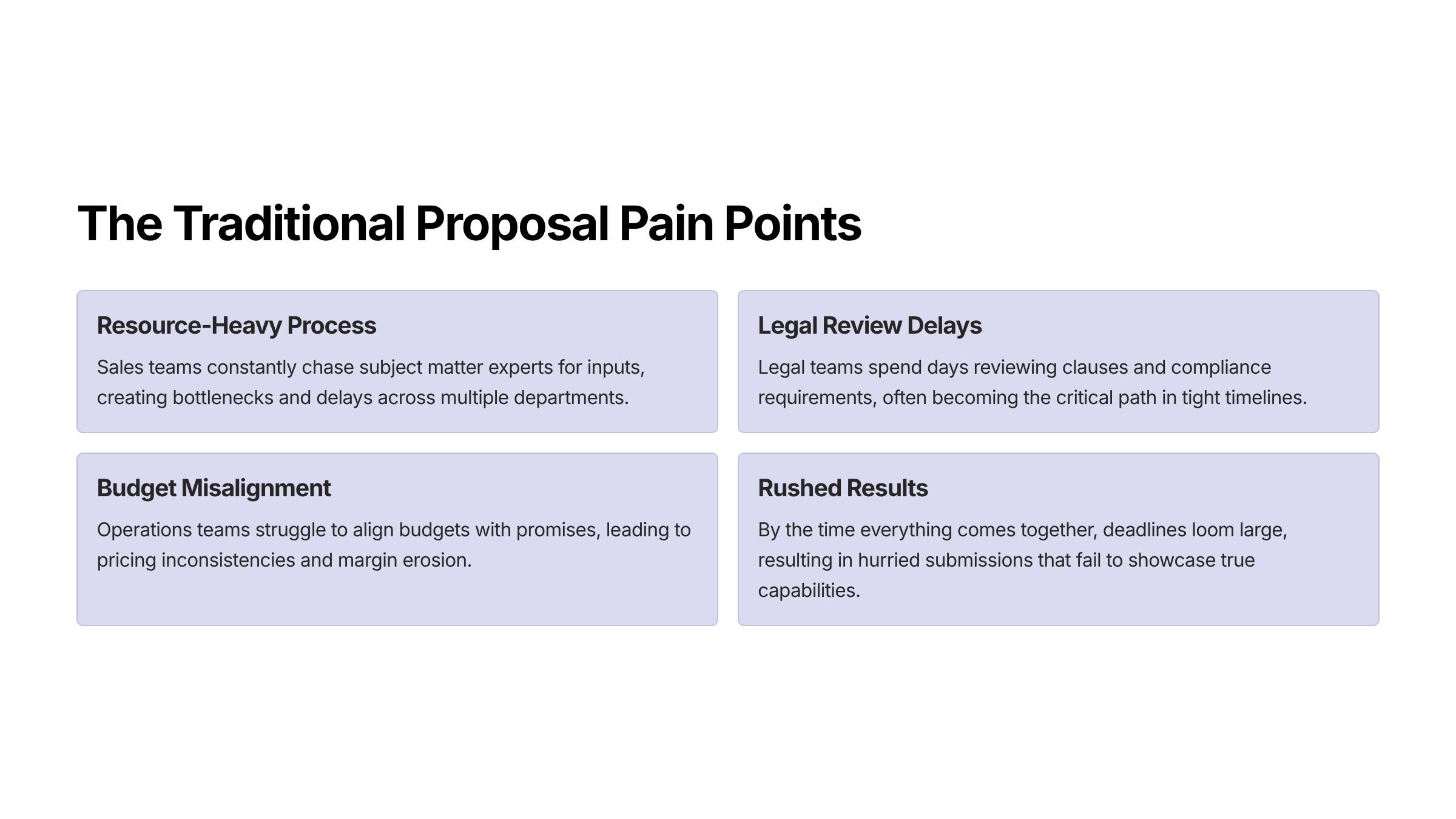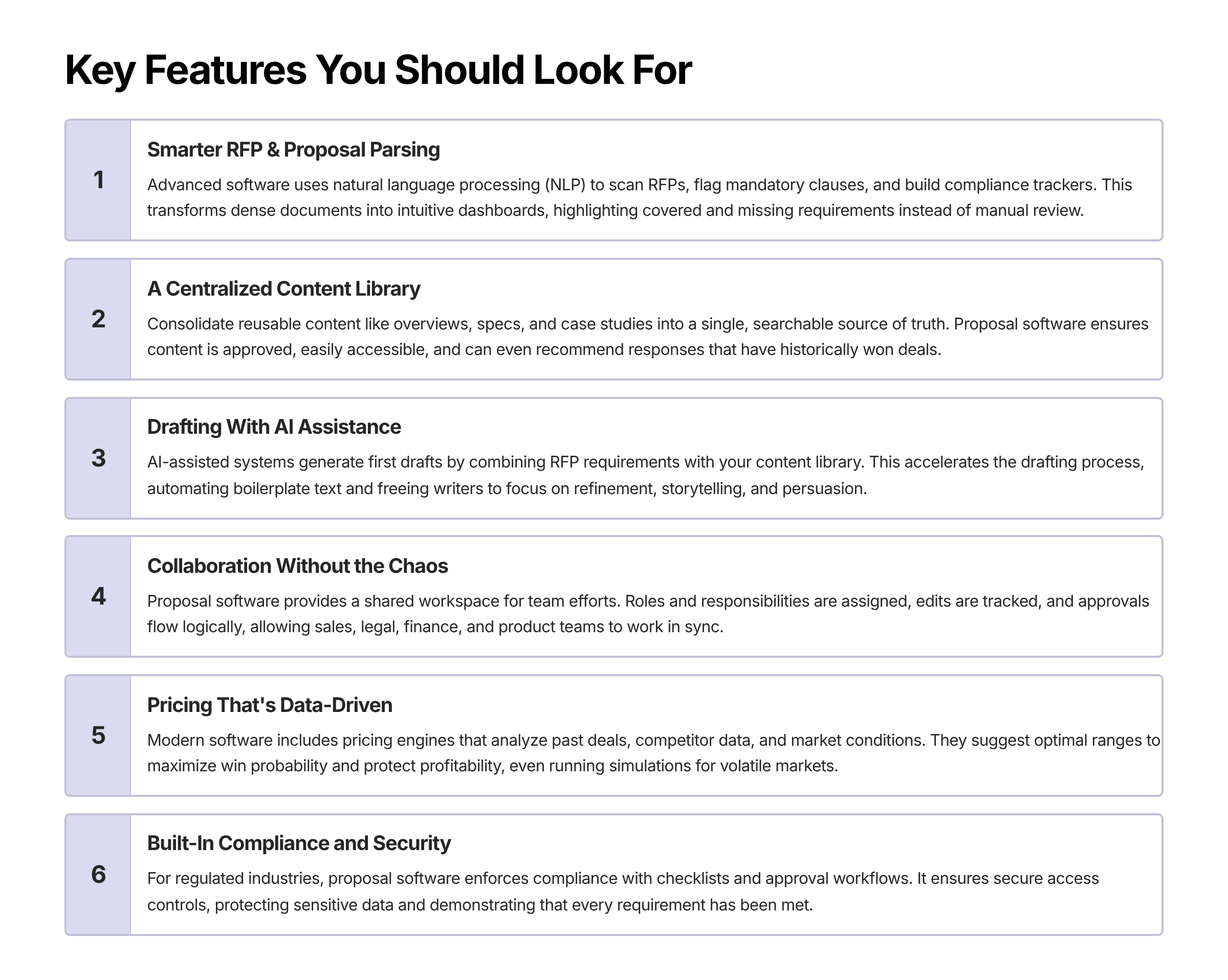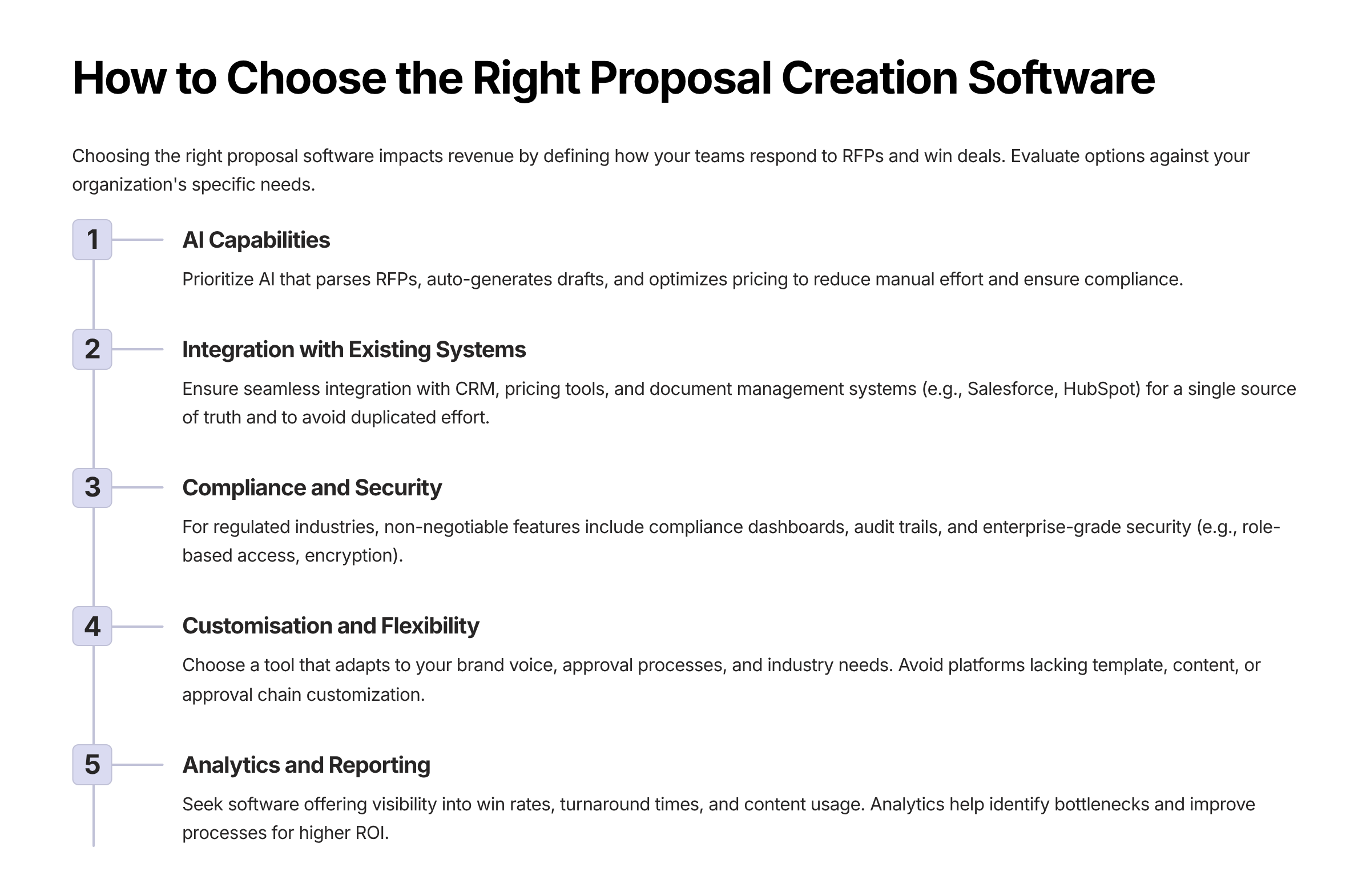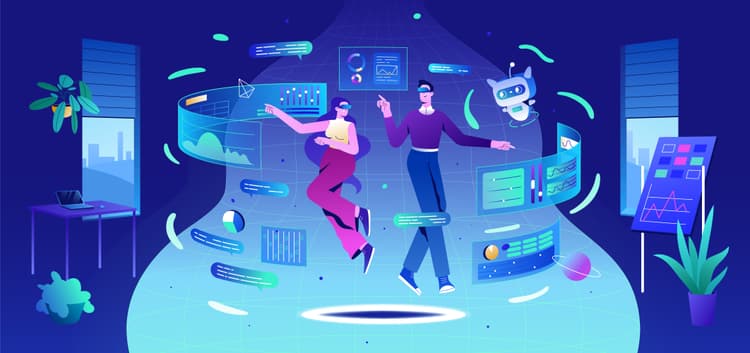Proposal Creation Software: Transforming RFPs into Revenue Engines
Article written by
Kate Williams

INSIDE THE ARTICLE
SHARE THIS ARTICLE
Summary
Most sales teams still rely on outdated templates and copy-paste chaos to send proposals—costing them deals. This blog breaks down why that approach fails and how modern proposal creation software fixes it. With faster turnaround, built-in personalization, and real-time insights, your team stops guessing and starts winning. Less scrambling, more closing.
Writing proposals has always been a resource-heavy process. Sales teams chase subject matter experts for inputs, legal spends days reviewing clauses, and operations teams struggle to align budgets with promises. By the time everything comes together, deadlines are looming, and the result feels rushed.
The proposal creation software emerged to solve this exact pain point. It turns proposal writing into a strategic capability: faster responses, tighter compliance, and smarter pricing decisions. In this blog, let's explore what proposal creation software is, the benefits, the challenges, and a few top tools that are already helping enterprises achieve 5x efficiency.
What Is Proposal Creation Software?
Proposal creation software is a tool that helps teams create and manage proposals more seamlessly and efficiently. But modern platforms go much further than formatting documents. Think of them as proposal engines that pull requirements from RFPs, suggest content from approved libraries, manage collaboration across teams, and even optimize pricing strategies.
Why Enterprises Are Adopting Proposal Creation Software
Enterprises are tired of the consequences of the traditional proposal management methods that used to drain their time, energy, resources, and revenue. Hence, the switch to proposal creation software was a no-brainer to most of them. Here are a few reasons organizations actually see in software:
- Faster turnaround: Development cycles shrink by 20–30%.
- Consistent branding and voice: Every proposal feels cohesive, even when written by multiple contributors.
- Higher win rates: By aligning pricing, messaging, and compliance, companies improve win rates.
- Better collaboration: Teams spend less time chasing inputs and more time refining strategy.
- Scalability: Instead of hitting capacity at 50 proposals a year, companies can handle hundreds without hiring dozens of writers.
For example: A consulting firm can cut proposal drafting time from 45 hours to 36 hours and see win rates climb from 32% to 42% in just six months. That kind of shift moves the needle on revenue.
Here's a quick look at the pain points of traditional proposal management:

Key Features of a Proposal Creation Software
There are so many features in tools available in the market right now. But choosing a platform concurrently means taking up features that are apt for your usage. Hence, here are a few core features that you should look for while choosing the right platform:
1. Smarter RFP & Proposal Parsing
If you’ve ever read a government RFP or a global enterprise bid, you know how dense and jargon-heavy these documents can be. Requirements are buried in paragraphs, deadlines are scattered, and eligibility rules hide in the fine print.
Traditional advice has always been to build a checklist. That still works—but now software does it for you. Advanced platforms use natural language processing to scan an RFP, flag mandatory clauses, and create a compliance tracker. Instead of flipping through 80 pages of requirements, you get a dashboard showing what’s covered and what’s still missing.
2. A Centralized Content Library
Most proposals are a mix of new and old content. Company overviews, product specs, case studies, and security certifications get reused constantly. The problem is that these live in random folders, emails, or someone’s desktop.
Proposal software builds a single source of truth with a unified content library. Need the latest ISO certification text or an updated customer case study? It’s already stored, approved, and searchable. More advanced tools go further—they learn which responses have historically won deals and recommend those first.
3. Drafting With AI Assistance
Blank pages are a proposal writer’s worst enemy. That’s where AI makes a real difference. Instead of writing boilerplate text from scratch, AI-assisted systems can generate a first draft by combining the RFP requirements with your content library.
The key here isn’t replacement—it’s acceleration. Writers still edit, refine, and add context, but the heavy lifting of structuring and populating a response is automated. This can cut drafting time in half and free up human effort for storytelling and persuasion.
4. Collaboration Without the Chaos
Proposals are team efforts, and without structure, they can quickly become a nightmare of version control and endless email threads. Proposal creation software acts as a shared workspace that enables seamless collaboration. Roles and responsibilities are assigned, edits are tracked, and approvals flow logically from contributor to reviewer to final sign-off.
The result? Sales, legal, finance, and product teams can all work in sync instead of stepping on each other’s toes.
5. Pricing That’s Data-Driven
In many proposals, the narrative is strong, but the pricing strategy is weak. Either companies underprice to stay competitive (and lose margin) or overprice and lose the deal entirely.
Modern software includes pricing engines that analyze past deals, competitor data, and market conditions. They suggest ranges that maximize win probability while protecting profitability. In volatile markets, these systems even run simulations to test how different scenarios could play out.
6. Built-In Compliance and Security
For industries like healthcare, finance, or government contracting, a missed compliance detail can sink an otherwise great proposal. Proposal software enforces discipline by including compliance checklists, approval workflows, and secure access controls. Sensitive data is protected, and teams can demonstrate that every requirement was met.

Use Cases of Proposal Creation Software Across Different Sectors
Proposals don’t look the same across industries. A SaaS vendor answering a Fortune 500 RFP has very different challenges than a university applying for a research grant or a pharmaceutical company submitting to a regulatory body. That’s why proposal creation software isn’t a one-size-fits-all tool—it adapts to the unique requirements of each sector. Here are some of the most common use cases where it makes a measurable difference:
- Technology & SaaS: Responding to enterprise RFPs with security addenda, integration details, and compliance checklists.
- Consulting & Professional Services: Coordinating proposals that need input from legal, finance, and multiple practice areas.
- Research & Academia: Writing structured funding proposals that align with grant requirements and community impact frameworks.
- Healthcare & Pharma: Submitting proposals that meet strict regulatory and ethical guidelines.
- Manufacturing & Industrial: Preparing complex bids that combine technical specs, compliance data, and variable pricing.
Now, let's see what the future of AI-powered proposal creation is and how to choose the right tool for your team.
Future of Proposal Creation Software: Human + AI
The conversation around automation often gets framed as humans versus machines. But when it comes to proposals, the future is clearly a partnership rather than a replacement. The most successful organizations have realized that proposal creation software works best when it complements human expertise instead of trying to replicate it.
Here’s how that balance plays out:
AI Takes Care of the Repetitive Work
- Parsing dense RFPs and pulling out key requirements.
- Drafting boilerplate content such as company overviews, compliance responses, or product specifications.
- Running simulations and crunching data to suggest pricing strategies.
- Maintaining version control and ensuring the latest approved content is always used.
Humans Add the Strategic Layer
- Crafting narratives that resonate with the client’s unique context.
- Using persuasion, empathy, and emotional intelligence to position value.
- Building trust through authentic examples, case studies, and relationships.
- Making judgment calls when proposals require nuance or creativity that software cannot replicate.
Why the Hybrid Model Works
- It reduces the burden on proposal teams by letting technology handle routine, error-prone tasks.
- It allows experts to spend their energy where it matters most: building compelling, client-specific arguments.
- It ensures that proposals are both efficient and human, combining accuracy with personality.
The outcome is not just faster proposal cycles but stronger proposals overall. When AI and humans collaborate, organizations produce responses that are thorough, compliant, and strategically sharp—without burning out their teams or diluting the human touch that wins trust.
How to Choose the Right Proposal Creation Software
Choosing the right proposal creation software isn’t just a tech decision; but a revenue decision. The platform you pick will define how your sales, legal, and operations teams respond to RFPs, collaborate across departments, and ultimately win or lose deals. With so many proposal automation tools in the market, from lightweight template apps to full-scale AI-powered proposal platforms, it’s important to evaluate them against the needs of your organization.
Here are the key factors to consider when comparing the best proposal creation software for your business:
1. AI Capabilities
Look for AI-driven proposal creation software that can parse RFPs, auto-generate draft responses, and even suggest optimized pricing. This reduces manual effort, ensures compliance, and gives your team a head start on every proposal.
2. Integration with Existing Systems
The best sales proposal software should connect seamlessly with your CRM, pricing tools, and document management systems. Integrations with platforms like Salesforce, HubSpot, or Slack ensure that proposals pull data from a single source of truth instead of duplicating effort.
3. Compliance and Security
For industries like healthcare, finance, and government contracting, compliance is non-negotiable. Choose proposal management software with built-in compliance dashboards, audit trails, and enterprise-grade security features such as role-based access and encryption.
4. Customization and Flexibility
Every company has unique workflows. A good proposal creation tool should adapt to your brand voice, approval processes, and industry requirements. Avoid one-size-fits-all platforms that don’t allow customization of templates, content libraries, or approval chains.
5. Analytics and Reporting
Modern proposal automation software goes beyond document creation—it should give you visibility into metrics like win rates, proposal turnaround times, and content usage. Advanced analytics help you identify bottlenecks and continuously improve your proposal process for higher ROI.
When evaluating proposal creation platforms, prioritize those that combine automation with adaptability. The right choice will help your team submit compliant, compelling, and timely proposals that close more deals.

A Quick Look at the Proposal Creation Software Market
Tired of looking for a platform that suits your enterprise needs? Here's a little breakdown of the top 6 proposal creation & management platforms that do the best work in the industry:
Tool | Best For | Strengths | Pricing |
|---|---|---|---|
Secure AI drafting, pricing optimization, compliance focus | Custom | ||
Mid-to-large sales teams | Content library, collaboration | Custom | |
Global enterprises | Strong parsing, analytics | Quote-based | |
SMBs & startups | Simple proposals + e-signature | From $19/user/month | |
Consulting & finance | Workflow, analytics | Quote-based | |
Freelancers/SMBs | Templates and branding | From $29/user/month |
Conclusion
As proposal creation software has matured, sales teams no longer see it as just an administrative tool—they treat it as a revenue engine. Platforms like SparrowGenie have transformed proposals from time-consuming paperwork into strategic assets that directly influence revenue outcomes. By combining human expertise with intelligent software, organizations are turning proposal creation into a true competitive advantage and a core capability for growth.
Ready to see how AI can transform your RFP process?
Product Marketing Manager at SurveySparrow
A writer by heart, and a marketer by trade with a passion to excel! I strive by the motto "Something New, Everyday"

